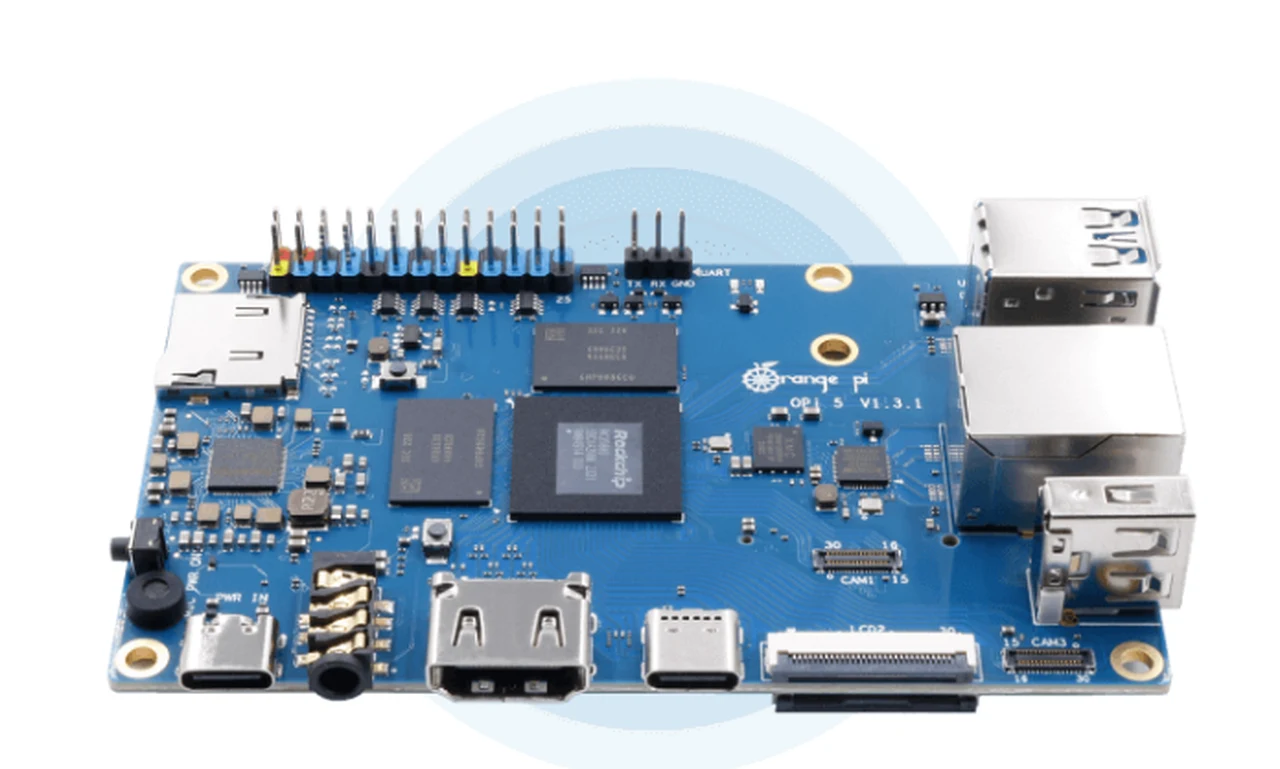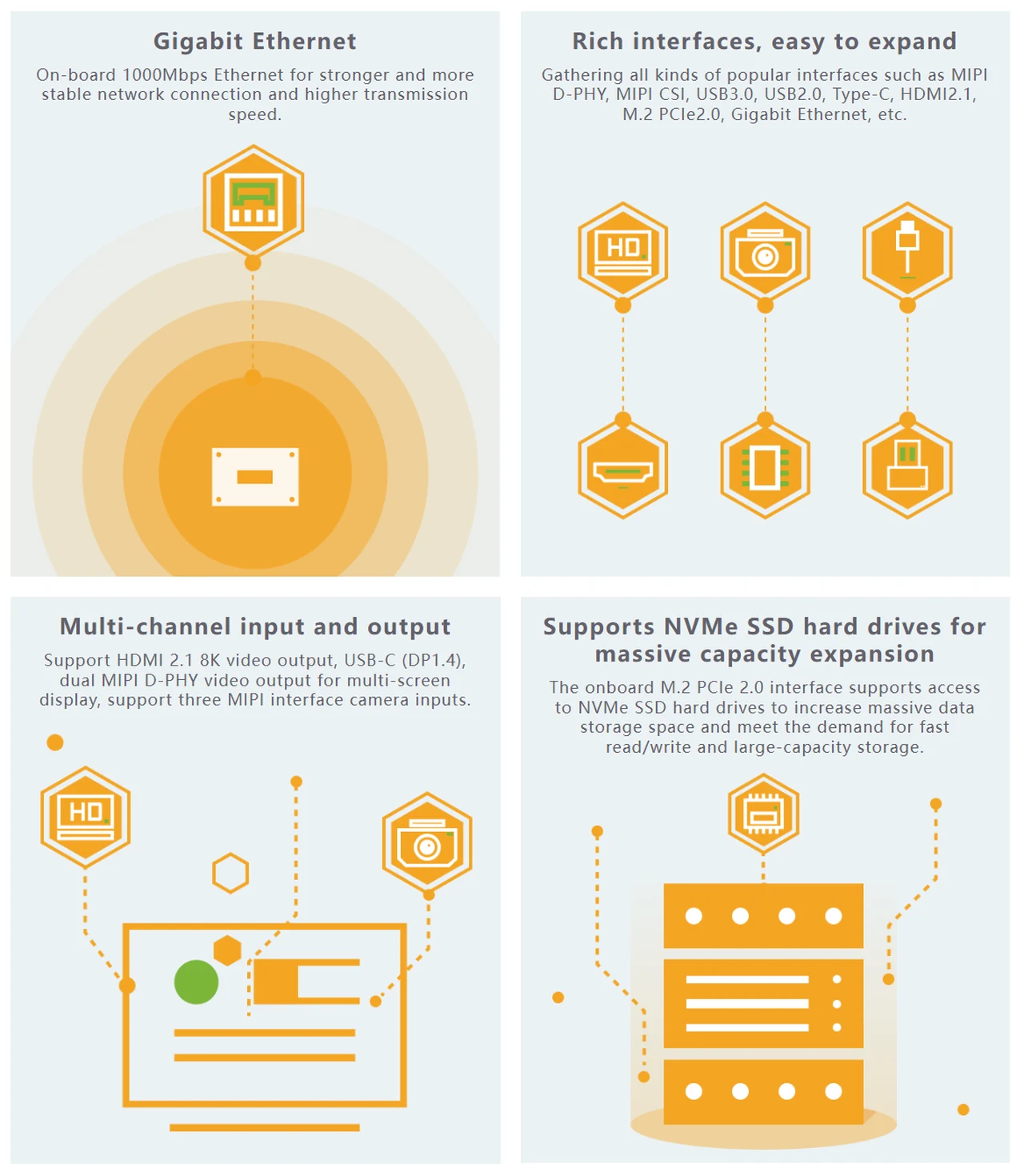When selecting a single-board computer (SBC) for your projects, understanding the technical specifications and performance capabilities is essential. The Orange Pi 5 Pro vs Raspberry Pi 5 stand out in the market, each offering distinct features and performance levels. This article provides an in-depth comparative analysis of these two models, focusing on the Orange Pi 5 Pro’s advancements in processing power, memory, connectivity, and expansion options, while also considering the Raspberry Pi 5’s strengths and community support.
Orange Pi 5 Pro vs Raspberry Pi 5 Comparison
Hardware Specifications
- Processor:
- Orange Pi 5 Pro: Equipped with the Rockchip RK3588S processor, which includes an 8-core setup with 4 Cortex-A76 cores at 2.4 GHz and 4 Cortex-A55 cores at 1.8 GHz.
- Raspberry Pi 5: Typically, Raspberry Pi models have utilized Broadcom processors, generally less powerful than the Rockchip offerings in terms of raw processing power and core counts.
- RAM:
- Orange Pi 5 Pro: Offers variants with 4GB, 8GB, or 16GB of LPDDR5 RAM.
- Raspberry Pi 5: Current models generally max out at 8GB of LPDDR4 RAM, indicating that the Orange Pi 5 Pro could offer better memory performance and larger capacities.
- Storage and IO:
- Orange Pi 5 Pro: Includes an M.2 M-key port for NVMe SSDs, USB-C for power, multiple USB ports (including USB 3.0 and 2.0), HDMI ports capable of up to 8K output, and a standard 40-pin GPIO header.
- Raspberry Pi 5: Typically includes a micro SD card slot, USB ports, HDMI capable of 4K output, and a similar 40-pin GPIO header.
Performance
- CPU and GPU: The Orange Pi 5 Pro’s processor is significantly more robust, with more cores and potentially higher clock speeds, giving it an edge in processing power, especially for multi-threaded tasks.
- NVMe Support: The presence of an M.2 slot on the Orange Pi 5 Pro provides options for fast storage solutions, although limited by a PCIe Gen 2×1 interface. Raspberry Pi models rely on micro SD cards or USB-connected storage, which might not match NVMe speeds.
Software Support
- Orange Pi 5 Pro: Tends to offer a variety of operating systems, including a custom Orange Pi OS, Arch Linux, and Android. However, the community and software support are generally seen as less extensive than Raspberry Pi.
- Raspberry Pi 5: Benefits from a vast and active community. The software support, including the availability of numerous specialized distributions and packages, is a significant advantage. This extensive support makes it more user-friendly, especially for beginners or those working on community-driven projects.
Pricing
- Orange Pi 5 Pro: Generally more expensive due to higher hardware specifications, especially in RAM capacity.
- Raspberry Pi 5: Typically offers a more cost-effective solution, although it might provide less power and lower RAM capacity.
Use Cases
- Orange Pi 5 Pro: Better suited for computationally intensive tasks, such as simulations, media servers, or as a mini PC given its robust CPU/GPU and higher RAM options.
- Raspberry Pi 5: Ideal for educational purposes, hobbyist projects, and general use where community support and software stability are crucial.
At the heart of any SBC lies its processor, which determines the device’s overall performance and capabilities. The Orange Pi 5 Pro is powered by the Rockchip RK3588S processor, featuring an impressive eight-core configuration divided into high-performance Cortex A76 and efficiency-focused Cortex A55 architectures. With 4x Cortex A76 cores running at 2.4 GHz and 4x Cortex A55 cores at 1.8 GHz, the Orange Pi 5 Pro offers a significant performance advantage over many of its competitors. In comparison, while the Raspberry Pi 5 is undoubtedly a powerful device, it may not match the raw processing power offered by the Orange Pi 5 Pro.
The Orange Pi 5 Pro’s graphics capabilities are further enhanced by the inclusion of an ARM Mali-G610 GPU. This advanced GPU enables the device to handle more demanding graphical tasks and supports 8K video output at 60Hz through its HDMI 2.1 port. This is a notable improvement over the typical 4K support found in many other SBCs, making the Orange Pi 5 Pro an attractive choice for projects that require high-resolution video output or advanced graphics processing.
Orange Pi 5 Pro vs Raspberry Pi 5
Here are some other articles you may find of interest on the subject of the Raspberry Pi 5
Memory and Connectivity Options
Memory is another crucial factor to consider when choosing an SBC, as it directly impacts the device’s ability to handle multiple tasks and process data quickly. The Orange Pi 5 Pro raises the bar with its support for up to 16GB of LPDDR5 RAM, surpassing the LPDDR4 RAM used in many other models, including the Raspberry Pi 5. The increased RAM capacity and the use of more advanced memory technology significantly enhance the Orange Pi 5 Pro’s multitasking abilities and its capacity to handle complex computations.

In terms of connectivity, the Orange Pi 5 Pro offers a comprehensive set of options, ensuring that it can seamlessly integrate with a wide range of peripherals and networks. The device features Wi-Fi 5, Bluetooth, and Gigabit Ethernet capabilities, providing users with fast and reliable wireless and wired connectivity options. Additionally, the Orange Pi 5 Pro includes a variety of USB ports—three USB 2.0 and one USB 3.0—allowing for extensive peripheral connectivity. This versatility makes the Orange Pi 5 Pro suitable for a broad spectrum of projects that require the use of external devices or sensors.
Expansion and Operating System Flexibility
Expansion capabilities are essential for users who need to customize their SBCs to meet specific project requirements. The Orange Pi 5 Pro caters to this need by including a 40-pin GPIO header that is compatible with Raspberry Pi. This compatibility is particularly beneficial for users who are looking to migrate from a Raspberry Pi setup or enhance their existing projects with the added performance of the Orange Pi 5 Pro. Furthermore, the device features an M.2 M key port for NVMe SSDs, allowing users to expand the storage capacity of their setup. However, it is worth noting that the speed potential of the connected SSDs may be limited by the single PCI Express lane available.
One of the key strengths of the Orange Pi 5 Pro is its support for a wide range of operating systems. The device is compatible with various versions of Orange Pi OS (based on Arch Linux and Android), Aunu, and Debian. This flexibility allows users to select the most suitable operating system for their specific project needs, whether they require the stability and community support of Debian, the customization options of Arch Linux, or the mobile app compatibility of Android.


While the Orange Pi 5 Pro features impressive CPU and GPU performance, advanced memory options, and extensive connectivity features, it is essential to consider some of its limitations. The device may face challenges in terms of I/O capabilities and software support compared to the well-established Raspberry Pi series. The Raspberry Pi benefits from a robust and active community, as well as a comprehensive software ecosystem, which can be crucial factors for many users when selecting an SBC for their projects.
The Orange Pi 5 Pro presents itself as an excellent choice for projects that demand high computational power, advanced memory configurations, and versatile connectivity options. However, it is crucial to carefully evaluate potential software compatibility issues and the level of community support available when making a decision. On the other hand, the Raspberry Pi 5, while potentially offering slightly lower raw performance, benefits from a strong community presence and a mature software ecosystem. Ultimately, the choice between these two capable SBCs will depend on the specific requirements and priorities of your project, taking into account factors such as performance, compatibility, and community support.
Video Credit: Source
Filed Under: Hardware
Latest TechMehow Deals
Disclosure: Some of our articles include affiliate links. If you buy something through one of these links, TechMehow may earn an affiliate commission. Learn about our Disclosure Policy.
